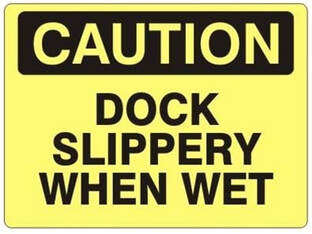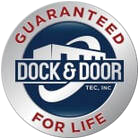|
We recently sat down with our OSHA Specialist to learn what their data says about the three biggest safety risks associated with loading docks.
Here's what OSHA recommends to prevent accidents and minimize risks:
As we head into the fall and eventually winter, we start to focus on keeping warm. Keeping the cold air from blowing through our doors. Keeping the temperature in that sweet spot of not too hot and not too cold. But what about water? Not just from fall rainstorms but from melting snow and ice.
We know. It’s September. Are we really talking about snow and ice? Yep. We are. Winter in the Midwest is hard. It can be brutal on your loading dock equipment and bottom line. It’s cold. It’s warm(ish). It’s sunny. It’s snowing. All of that can cause chaos with your loading dock equipment. Melting (and then refreezing) snow and ice pose serious safety concerns and performance problems at your loading docks. Safety Concerns Slippery docks are dangerous to your employees and visiting drivers alike. The potential for someone to slip and fall greatly increases if your docks are not properly sealed and water or ice is present. Forklifts going in and out of trailers will transfer water throughout your facility, creating even more chances for someone to slip and fall. This can lead to injuries, time off, workers comp – all of these can be avoided by paying closer attention to your loading dock and the potential for water infiltration. Compliance Concerns Ever smelled a stagnant swamp or bucket of water? Standing water can become a breeding ground for harmful bacteria. Bacteria poses numerous threats to the health of your staff and food facilities can be a major violation of the FDA Food Safety Modernization Act (FSMA) requirements. FSMA requires you to have a food safety plan in place that includes an analysis of hazards and risk-based preventive controls to minimize or prevent the identified hazards. A pest infestation can be another violation, especially in food and pharma facilities. Any gaps in your seals or equipment can lead to issues with requirements and compliance. Performance Problems Have you ever tried to pry something off the ground that good ole’ Mr. Winter has frozen? Say your garbage can after it’s been sitting for a week with constant thaw and freeze. Not a whole lot of fun and sometimes an unsuccessful venture. Now imagine that at your loading docks. Imagine melted ice and snow working its way down into your metal loading docks and thawing and refreezing. Over and over again. Many repairs we perform during the winter could be prevented by properly maintained and sealed equipment. A nagging or small issue in July can become a big problem in December So, what should I do?
Check out our other blogs on facility modernization and safety for more ideas on how to improve your facility and your bottom line. As always, we hope you find this information useful and you find something that you can do in your facility to help prevent the winter blues. Please contact us with any questions or concerns. I recently worked with a client that had a need for vehicle restraints. The company is very safety conscious and noticed they were having some issues with trailers creeping away from their loading docks even though they had been chocked. During our conversation we discovered that the company was handling loads with various trailer types; refers, a straight truck with lift-gates, and standard trailers. They, of course, had been looking at a few different dock equipment companies to provide solutions for their facility and had been given the basic information on standard hook restraints. The question is, will these work.
When your facility is looking into vehicle restraints, there are some basic rules of thumb that should be taken into account. 1.) What is your company’s protocol for securing trailers at the loading dock? 2.) What types of trailers does your facility receive at the loading dock? 3.) What policy will you have in place regarding communication between your dock and the driver? In the case above, no one took into account that the same dock will receive both standard trailers and lift gates. While the external hook restraints will work for the standard trailers and refers, the problem came in with the lift gates. The gates are lowered before the truck backs into the dock. This renders the restraint useless and they could be damaged by the gate being in the lowered position and backing into them. The solution. A pit hook restraint. These mount under the dock and are fully retracted when not in use. This allows for the hook to engage the rig bars on your standard trailers and refers and communicates with the drivers that their vehicles are secured. Now, how do you secure your lift gate trucks? What is your protocol for communicating with the dock and drivers as to who is secured and who isn’t? We looked at the situation, spoke with the facilities coordinator and came up with a complete two-part solution for their individual need. In most cases, loading docks will be able to use one type of vehicle restraint or another. The question is, are you asking the right questions when dealing with a dock equipment company? How do you know the equipment will work for your situation and be cost-effective? I hope this information is helpful if you are looking into vehicle restraints. If you would like more information on what questions you should ask or for information on the different types of solutions that are available, please feel free to contact us directly. When is the ideal time for your critical equipment to break? I would guess your answer would be never. Since we all live in reality we know every piece of equipment could break at any given time. No matter how good the manufacturing process, no matter how good your maintenance program is, sometimes parts just break. If you have ever had to make an urgent call, all the while hoping that you can get a technician out to take a look at it and then hoping beyond hope that the service technician has the parts on his truck to fix the problem, you understand the stress.
Over the past several years I have seen a subtle change that moves the chances of a quick repair from a 50/50 gamble to almost a certainty. This strategy is not “a weird little trick” it is a sound business decision. More and more companies are stocking parts for their critical equipment. Having parts on hand eliminates one of the most common factors, out of stock parts. Just call in your service company or have your qualified maintenance mechanic make the repair. As the saying goes “Control what you can control.” Just this morning I got a call from one of our rural clients, a 3PL that runs at full capacity. Their docks and doors are critical. Over the weekend they had a door spring break. They had a replacement spring on the shelf and were able to replace the broken spring and get the door working. Now, I don’t recommend just anyone climb a ladder and start replacing door springs as winding springs can be a dangerous endeavor. They have qualified mechanics on staff and of course, had the parts they needed. After their call, I ordered a replacement spring and in a couple of days, they will have their new door spring on the shelf. We also have several clients that keep parts for their loading docks on hand. Some clients do their own work and some call on us to provide service. Control what you can. If you need help in determining which parts you should stock we can help. Finally, summer is upon us. The snow is gone, the days are warmer and your warehouse doors seem to stay open day and night to allow the breeze to pass through.
As temperatures outside heat up so do temperatures inside. Things can start to get downright hot in the warehouse. A deceivingly gentle breeze across a hot asphalt parking lot can actually raise the ambient temperature in your warehouse by several degrees. Couple this with a busy work environment and you could have a formula for heat exhaustion or heat stroke of employees. This can and has happened in warehouses across the United States. How can you keep your cool? One easy and cost-effective way is to invest in HVLS fans. These are designed to circulate large volumes of air at very low speeds. By keeping the air moving throughout your warehouse it keeps the ambient temperature down while allowing the doors to be open and the breeze in. They also help to keep humidity down and cut down on dependency on your HVAC system. But, this leads to another dilemma… Pests and Birds… You have your HVLS system moving air, the doors are open, everyone is in a little better mood, until… The bird and bugs make their way in. How much production is lost swatting bugs or chasing birds out of the warehouse? This could be a popular discussion topic on its own here in Minnesota. Do you have swarms of flying insects being “Drawn to the lights” just to die off and fall on your inventory? To prevent pests from getting in while allowing the doors to be open and the breeze to flow simply invest in affordable dock screen-style doors. No more swatting mosquitoes or chasing birds around. Just a nice, comfortable warehouse and productive employees. Don’t let summer go by without enjoying what it has to offer. Consult with professionals now who can help evaluate your situation and provide proper solutions. |
AuthorVarious. Categories
All
Archives
August 2023
|
- Home
- About
- Career Opportunities
- Services
-
Equipment
- Dock Locks (Truck Restraints) >
- Fans & In-Plant Equipment >
-
Industrial / Commercial Doors
>
- High Speed Fabric Doors
- Security High Speed
- Rubber Doors
- Fire Door
- Rolling Steel
- Impactable Dock Doors
- Cooler / Freezer
- Fabric Roll-Up
- Impact / Traffic / Bump
- Overhead / Sectional Doors
- Operators / Activation
- Air Curtains / Screen & Bug Doors
- Strip Doors
- Door Entrapment Protection
- Door Protection
- Overhead Door Upgrades
- Loading Dock Levelers & Lifts >
- Loading Dock Seals & Shelters >
- OEM & Aftermarket Parts
- Safety / Energy / Security / Employee Comfort >
- Yeti Snow Removal
- Markets
- Blog
- Contact
Dock & Door Tec
Serving Minnesota, Wisconsin, Iowa, North Dakota & South Dakota
Serving Minnesota, Wisconsin, Iowa, North Dakota & South Dakota


 RSS Feed
RSS Feed
